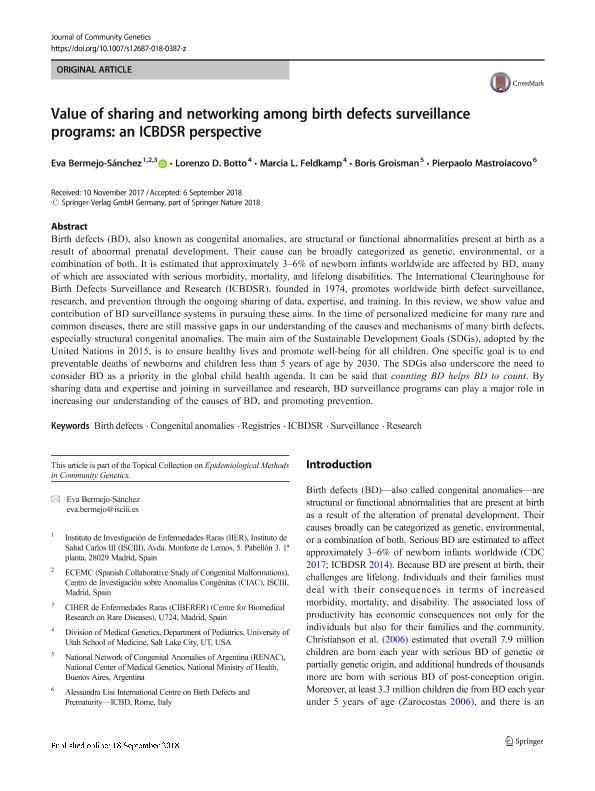Mostrar el registro sencillo del ítem
dc.contributor.author
Bermejo Sánchez, Eva
dc.contributor.author
Botto, Lorenzo

dc.contributor.author
Feldkamp, Marcia L.
dc.contributor.author
Groisman, Boris

dc.contributor.author
Mastroiacovo, Pierpaolo

dc.date.available
2022-11-15T14:50:04Z
dc.date.issued
2018-10
dc.identifier.citation
Bermejo Sánchez, Eva; Botto, Lorenzo; Feldkamp, Marcia L.; Groisman, Boris; Mastroiacovo, Pierpaolo; Value of sharing and networking among birth defects surveillance programs: an ICBDSR perspective; Springer; Journal of Community Genetics; 9; 4; 10-2018; 411-415
dc.identifier.issn
1868-310X
dc.identifier.uri
http://hdl.handle.net/11336/177845
dc.description.abstract
Birth defects (BD), also known as congenital anomalies, are structural or functional abnormalities present at birth as a result of abnormal prenatal development. Their cause can be broadly categorized as genetic, environmental, or a combination of both. It is estimated that approximately 3–6% of newborn infants worldwide are affected by BD, many of which are associated with serious morbidity, mortality, and lifelong disabilities. The International Clearinghouse for Birth Defects Surveillance and Research (ICBDSR), founded in 1974, promotes worldwide birth defect surveillance, research, and prevention through the ongoing sharing of data, expertise, and training. In this review, we show value and contribution of BD surveillance systems in pursuing these aims. In the time of personalized medicine for many rare and common diseases, there are still massive gaps in our understanding of the causes and mechanisms of many birth defects, especially structural congenital anomalies. The main aim of the Sustainable Development Goals (SDGs), adopted by the United Nations in 2015, is to ensure healthy lives and promote well-being for all children. One specific goal is to end preventable deaths of newborns and children less than 5 years of age by 2030. The SDGs also underscore the need to consider BD as a priority in the global child health agenda. It can be said that counting BD helps BD to count. By sharing data and expertise and joining in surveillance and research, BD surveillance programs can play a major role in increasing our understanding of the causes of BD, and promoting prevention.
dc.format
application/pdf
dc.language.iso
eng
dc.publisher
Springer

dc.rights
info:eu-repo/semantics/openAccess
dc.rights.uri
https://creativecommons.org/licenses/by-nc-sa/2.5/ar/
dc.subject
BIRTH DEFECTS
dc.subject
CONGENITAL ANOMALIES
dc.subject
ICBDSR
dc.subject
REGISTRIES
dc.subject
RESEARCH
dc.subject
SURVEILLANCE
dc.subject.classification
Epidemiología

dc.subject.classification
Ciencias de la Salud

dc.subject.classification
CIENCIAS MÉDICAS Y DE LA SALUD

dc.title
Value of sharing and networking among birth defects surveillance programs: an ICBDSR perspective
dc.type
info:eu-repo/semantics/article
dc.type
info:ar-repo/semantics/artículo
dc.type
info:eu-repo/semantics/publishedVersion
dc.date.updated
2022-11-14T11:18:40Z
dc.identifier.eissn
1868-6001
dc.journal.volume
9
dc.journal.number
4
dc.journal.pagination
411-415
dc.journal.pais
Alemania

dc.description.fil
Fil: Bermejo Sánchez, Eva. Instituto de Salud Carlos III; España
dc.description.fil
Fil: Botto, Lorenzo. University of Utah School of Medicine; Argentina
dc.description.fil
Fil: Feldkamp, Marcia L.. University of Utah School of Medicine; Argentina
dc.description.fil
Fil: Groisman, Boris. Consejo Nacional de Investigaciones Científicas y Técnicas; Argentina
dc.description.fil
Fil: Mastroiacovo, Pierpaolo. No especifíca;
dc.journal.title
Journal of Community Genetics
dc.relation.alternativeid
info:eu-repo/semantics/altIdentifier/doi/http://dx.doi.org/10.1007/s12687-018-0387-z
Archivos asociados
